by
K.A. Savvaitova
Faculty of Biology, Moscow State University, Vorobevy gory, Moscow, 119899 Russia
and
T. Petr
27 McLeod Street, Toowoomba Qld 4350, Australia
In 1938, the waters of Lake Sevan in Armenia started to be drawn for hydropower production and for irrigation. The lowest level was reached in 1952. This was followed by a gradually rising water level, with a return to normal in 1967, and then subsequent fluctuations of water level according to the demands. At present the water level is kept at around 1898 m of altitude, with 1244 km2 of surface area, with an annual drawdown for hydropower production and irrigation. The impact of the drawdown and water level fluctuations on water quality and fish stocks have been considerable. Prior to the lake water level manipulation the endemic Sevan trout (Salmo ischchan) and Sevan khramulya (Varicorhinus capoeta) dominated in the fish landings. Drawing the water from the lake eventually led to an almost disappearance of the Sevan trout which became listed as an endangered fish species. The decline had two major causes: desiccation of spawning grounds and submersed macrophytes, and eutrophication of the lake. Countermeasures employed by fishery managers were: introduction of the pelagic whitefish (Coregonus lavaretus), which now represents 80% of the total fish catch, and minimising water level fluctuation as much as possible. It is planned to gradually increase the water level in order to restore some of the lost trout spawning grounds, increase the dissolved oxygen levels and reduce eutrophication.
Lake Sevan in Armenia (Fig.1) is an example of a highly manipulated coldwater lake, the primary purpose of which is the production of hydroelectric power, and to a lesser extent diversion of water for irrigation. Initially, the water level in the lake was at 1906 m above sea level and the lake covered 1416 km2. Under the impact of water discharges for the power station and for irrigation, the lake water level has been subject to considerable fluctuations. Immediately after the Second World War the water level started rapidly declining, and it took 15 years before the lake again reached its full water volume in 1967. Since then the rate of fluctuation has been less dramatic. In 1990 the lake level was at 1897.5 m, which was approximately 18.5 m below the nominal water level, and it covered an area of 1244 km2 (Parparov, 1990).
Lake Sevan and its fish fauna have been facing problems since several dams blocked the Razdan River, the only outflow from the lake. The rationale behind the dams construction
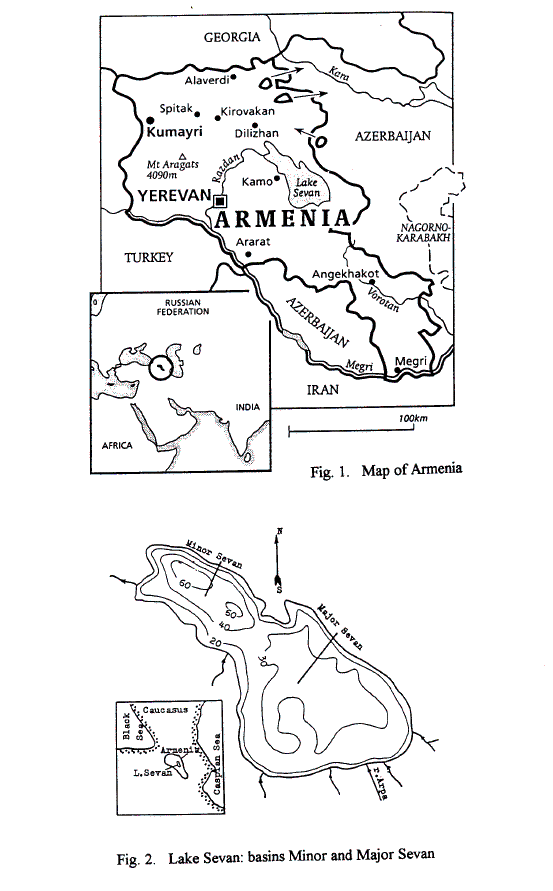
was to produce an irrigation and power-generation system of dams which would increase the rate of discharge from the lake while at the same time reducing evaporation as a result of the
reduction in the lake surface area. The discharge of the lake water, the subsequent rise and level fluctuations, led to irreversible damage of spawning grounds of the endemic trout, which, combined with eutrophication (Oganesyan and Parparov, 1983; Bagramyan, 1984), led to major changes in the lake fish species composition. To halt further worsening of the situation and to prevent a further fall in water level, but at the same time to satisfy the demands of irrigation and power generation, a number of pumping stations (Erevanskaya, Razdanskaya, Tatevskaya, Armyanskaya) were constructed and a tunnel cut through the mountains to transfer about 200 million m3 of water to the lake from the watershed of the Arpa River. Later on, another tunnel was constructed to transfer part of the waters of the Vorotan River to the lake. These measures brought a total of 420 million m3 of water annually from the new sources, and it is expected that during the first decade of the 21st century the water level of the Sevan will be raised by 6 m, this in turn changing the eutrophicated lake back to an oligotrophic character (Bagramyan, 1984). However, this may be too late for Sevan trout, the formerly major fish species, to come back in the same numbers as previously which supported a lucrative fishery (Meybeck et al., 1997).
The present paper reviews the changes in fish stocks of Lake Sevan in retrospect, focusing on fishery management measures undertaken during this century to counter the negative impacts resulting from multiple use of a water resource, where fishery was given a low priority. The future of the lake fishery is also discussed.
2.1 Morphometry
Lake Sevan is a large, high-mountain freshwater lake. It is located in the northeastern part of Armenia at an altitude of about 1900 m, depending on the water drawdown. The lake is of tectonic origin. Its largely triangular shape has elongations in the southwestern and northwestern directions. The lake is 75 km long, with a mean width of 19 km. Water level decline by 18.5 m led to a 12.2% reduction in the lake surface area, which in the 1980s was 1244 km2 (Parparov, 1990). The Artanish Peninsula and Cape Noraduz subdivide the lake into two areas, the Minor Sevan and Major Sevan (Fig. 2). Twenty-eight small rivers enter the lake, but there is only one outflow, the Razdan. Spring floods and snowmelt are the main sources of water. Wind force is an important factor influencing water mixing, with the northern and northwestern winds predominating. While in the deeper zone the wind mixes only the upper layers of water, in shallows water mixes down to the bottom. The bottom is sand or sand and clay. Sevan lake water started to be used for power generation in 1938 and since then the lake water volume has been reduced by 42.2%. The maximum depth has been reduced from 98.7 m to 42.2 m in the Minor Sevan and from 58.7 m to 40.2 m in the Major Sevan, and the average depth from 50.9 m to 39.2 m, and from 37.7 m to 23.6 m, respectively.
2.2 Temperature
Lake Sevan, at a latitude of 40oN, is a fairly warm lake. The average annual surface water temperature is 10-12oC. The minimum water temperature of 1-2oC is reached in January to April. During winter the water is not stratified. The lake freezes over every year. In August the maximum surface water temperature may reach 19oC. During summer the water is stratified, with the hypolimnion situated at 25-30 m depth. From October to December the lake water column is mixed from the top to the bottom, with the same temperature throughout (Gezalyan, 1979).
Water temperature starts rising during the first half of March. Near the mouths of rivers entering the lake the water warms up faster than in the main body of the lake. Water thermal stratification in the upper 10 m begins to develop in late May. In June the epilimnion in the Minor Sevan already reaches 15-20 m, which is close to that of the Major Sevan. Horizontal temperature gradients develop in the lake in June or July. Water starts to cool in September and this continues until the first half of January. The wind-induced mixing of water contributes to the breakdown of stratification. In the Major Sevan the water is fully mixed in October-November at a water temperature of 11-12oC; in the Minor Sevan this occurs at 5oC in November-December. At present, the water in the Major Sevan the water starts mixing one month earlier and at a temperature 3-4oC higher than in the past, prior to the manipulation of water level. In the Small Sevan the decline in the water level has not changed the onset of water mixing and thermal stratification. With the water level decline the autumnal water temperature near the bottom rises. Prior to the man-induced water level drop, the water temperature of the Major Sevan hypolimnion stayed at 8oC or less. Since 1965 the temperatures have reached almost 15oC.
In the past the lake froze once every 3 or 4 years but now it freezes every year and the ice cover which may be 30-40 cm thick, may stay from the end of January until early April. Under the ice the water may show reverse stratification, with the upper layers having a temperature close to zero and the bottom layer 1.2-2.3oC (Gezalyan, 1979).
2.3 Dissolved oxygen concentration
Concentrations of dissolved oxygen in the littoral zone range between 6.23 and 11.08 mg l-1 and in the central part of the lake between 4.56 and 11.6 mg l-1 (Gezalyan and Khorlashko, 1979). In 1928 the highest dissolved oxygen content was recorded in spring, after the water column was thoroughly mixed, at a water temperature of 4oC. In autumn the dissolved oxygen concentration declined. The average oxygen minimum was never less than 5.6 mg l-1, with the maximum reaching 11.8 mg l-1 (Lyatti, 1932). In 1947 the lowest oxygen concentration was reached in November. Since the 1970s the dissolved oxygen concentration near the bottom has become very low throughout the lake with zero values reached at the end of the stratification period (Parparov, 1990). This situation seems to be directly related to eutrophication.
2.4 Water chemical composition
Comparison of the chemical composition of water (Table 1) shows changes from 1929 to 1983. The lake had a high pH of 8.4. Among the dominant cations there was no change in the concentration of Mg and moderate changes in concentrations of Ca, Na and K. Bicarbonates dominated. Concentrations of sulfates did not change, but there was a slight increase in chlorides. The data did not indicate any changes in the concentration of Si. There was a conspicuous decline in dissolved oxygen, with a total deoxygenation of water recorded in the more recent years. This also explains the increase in nitrate/nitrite nitrogen, ammonia and iron (not in Table 1) where Parparova (1979) detected 0.014 mg l-1.
The changes in dissolved oxygen and the increase in nitrogen and iron are indicators of the eutrophication process in Lake Sevan. The major causative factors behind this are seen in the gradual lowering of the water level, which made the lake shallower, and the increased discharge into the lake of poorly treated sewage.
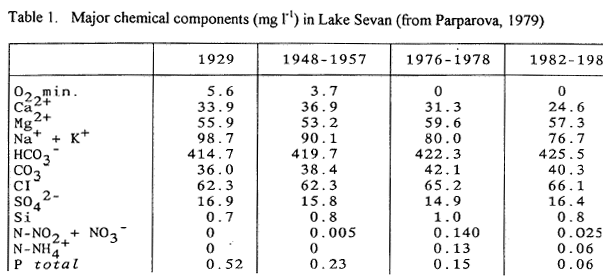
2.5 Hydrobiological characteristics
Since the 1960s the lake has been undergoing changes in the composition of phytoplankton, zooplankton and benthos. Before the irreversible draining of the lake started, 26 species of algae were listed for the lake pelagial. The most common of them were the diatoms Asterionella formosa, Stephanodiscus astraea and S. hantzschii, the green algae Gloeococcus schroeteri and the genus Oocystis. The species number was small at that time. Since 1964, explosive growth of blue green algae such as Anabaena lemmermanii became a regular feature of the lake, causing blooms (Legovitch, 1979). In the 1970s the phytoplankton composition changed, with new species occurring and some of the previous species disappearing. Most of the new algal species belonged to the Protococcales, and they included Ankistrodesmus angustus, Hyaloraphidium rectum, Lagerheimia, Golenkiniopsis, Treubaria, Tetrastrum and some others. The genus Euglena established itself in the pelagic zone. The diatoms Melosira italica, Peridinium sp., Closterium and Mougeotia sp. appeared (Kazaryan, 1979). A comparison of the situation in 1952 with that in 1979 showed that the biomass of phytoplankton increased 22 fold, i.e. to 18 g m-3 in the Major Sevan, and 10 fold, i.e. to 7.3 g m-3 in the Minor Sevan. There was a considerable increase in the biomass of Melosira italica to 3 g m-3 corresponding to 15 million individuals per litre, and Hyaloraphidium rectum (0.32 g m-3, 61 million ind. l-1) (Kazaryan, 1979).
Before the water level decline in 1938, the lake bottom flora down to 14 m depth was dominated by stonewort (Chara) and moss. But after that the number of species and their biomass were down to one tenth of the previous levels. By 1976 Chara and previously common Potamogeton natans, P. pusillus, P. densus and Zannichelia palustris, almost disappeared (Gambaryan, 1979).
When the water level started to drop in 1938, the zooplankton composition remained stable for considerable time. There were 10 species of rotifers, cladoceran and copepods, all common. The highest biomass was that of copepods, which represented about 60% of the total, and that of the cladoceran Daphnia (Tables 2 and 3). Gradually, the species composition started to change, which was accompanied by changes in the biomass of the individual species. During 1974-1980 smaller zooplankton became dominant, with rotifers representing up to 80% of the biomass. This changed again during 1981-1985, when rotifer biomass decreased to 60-65% of the total biomass while that of Daphnia and Cyclops increased (Simonyan, 1988). Thus, three major periods in zooplankton biomass can be distinguished: 1937-1969 - low biomass; 1972-1979 - high biomass; 1980-1984 - low biomass (Table 4).
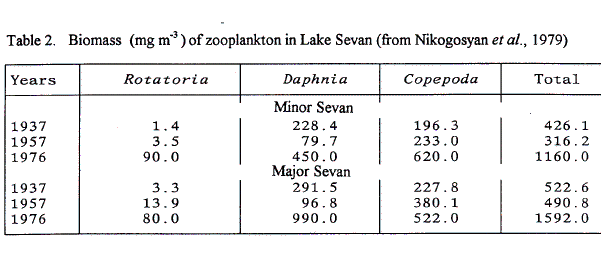
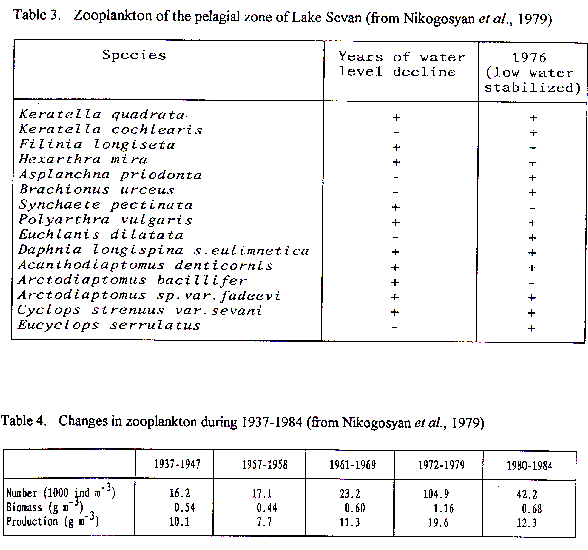
Zoobenthos of Lake Sevan is dominated by chironomid larvae (Chironomus plumosus, C. markosjani, Procladius sp., Glyptotendipes barbipes), Oligochaeta (Potamothrix hammoniensis, Tubifex tubifex), leeches (Herpobdella octoculata, Hellobdella stagnalis, Glossiphonia complanata), bivalves (Pisidium nitidus and P. casertanum), snails (Valvata piscinalis, Limnaea stagnalis, Radix ovata), mayflies (represented in the lake by only one species Caenis modesta), and gammarids (Gammarus lacustris) (Arnoldi, 1929; Ostrovsky, 1983). In 1929 gammarids and chironomids dominated benthos with the other groups forming only an insignificant portion of the biomass. This was representative for the oligotrophic character of Sevan in that year. During 1938-1948 oligochaetes represented 36.2% of the biomass, and gammarids 34.6% (Fridman, 1950). In 1955-1967 oligochaetes still dominated, followed by chironomids, while the biomass of gammarids declined and the biomass of molluscs more than doubled. Leeches remained unchanged (Markosyan, 1959; Meshkova, 1976). More recently, the biomass of chironomids has risen to the initial level (60.5%), and that of oligochaetes to 37.7%; the biomass of molluscs tripled compared to that for the period 1938-1948 (Table 5). However. The biomass of gammarids sharply declined as a result of the reduction in the area and biomass of submersed aquatic macrophytes and in the area of stony and sandy bottom (Markosyan, 1959). There has also been increasing foraging on gammarids by coregonids (Dadikyan, 1955; Pivazyan, 1984).
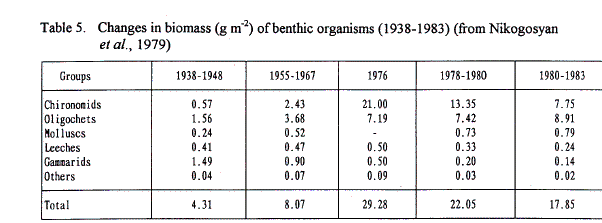
Lake Sevan has an endemic fish fauna represented by only three species: Sevan trout (Salmo ischchan Kessler), Sevan khramulya (Varicorhinus capoeta sevangi Filippi) and Sevan barbel (Barbus lacerta goktchaicus Kessler). However, more fish species were introduced in the past in order to increase fish catches: Ladoga whitefish (Coregonus lavaretus ladoga) from Lake Ladoga, and Lake Chud whitefish (Coregonus lavaretus maraenoides). Both species, introduced in 1924, not only established themselves in Sevan, but also crossbred producing a new hybrid Coregonus lavaretus sevanicus Dadikjan (Dadikyan, 1986).
Giebel carp (Carassius auratus gibelio Bloch) was also inadvertently introduced in the early 1980s and established strong stocks in areas rich in aquatic macrophytes.
While Sevan trout and Sevan khramulya were common in the lake before the water level started to decline, their stocks later diminished drastically. In 1984 both species were listed in the Red Book of the USSR (1984). Stocks of Sevan barbel also declined and the species is now listed in the Red Book of Armenia. Khramulya stocks remain stable and coregonid stocks have strongly increased.
3.1 Biology of Sevan fish
3.1.1 Sevan trout - Salmo ischchan
Sevan trout is represented by four subspecies, distinguished from each other by a number of morphological traits.
"Winter" Sevan trout (Salmo ischchan ischchan)
In the past the lake was richly populated by so-called "winter" Sevan trout, a strictly lacustrine form seeking food and spawning nowhere else but in the lake. This subspecies split into two types, alpha and beta (Fortunatov, 1927), The alpha type spawned from early November to the end of December in shallows (0.5-5m depth) on sand and gravel of the littoral along the northwestern shore of the lake. Spawning grounds of this type covered 17 ha (Pavlov, 1951). The beta type spawned from January to March in the southeastern part of the Large Sevan, down to 22 m. Spawning grounds of this type covered 5 ha. The alpha type spawned at 1-3oC, the beta type at -0.3-3oC (Fortunatov et al., 1932; Dadikyan, 1986). Alpha reached sexual maturity at the age of 5-6 years, beta two years later and from then on they spawned every year (Dadikyan, 1986). Unlike the other subspecies, the "winter" Sevan trout was very prolific, producing up to 8700 eggs (Pavlov, 1951). The fish grew to a length of up to 90 cm and a weight of up to 15 kg, and it was a fast grower. Dead individuals 80 cm long and weighing about 8 kg were often seen in the lake before the water level began to drop. The "winter" Sevan trout fed on benthos: Gammmarus constituted 90-95% of the total weight of the food (Dadikyan, 1986). The lake used to yield about 150 t annually of the "winter" Sevan trout. The alpha type was more common than the beta type. However, as the water level declined, the alpha type lost its spawning grounds and when the water level drop reached 10 m this type became extinct. The beta type survived because its spawning grounds were located deeper and therefore were not getting exposed. However, its catches became negligible (Dadikyan, 1986).
Gegarkuni Sevan trout (Salmo ischchan gegarkuni)
In the past gegarkuni Sevan trout was a common Sevan fish. Currently it is present only in the Major Sevan. In winter it stays in the open parts of the lake. Starting in April it enters the littoral, and in summer, as the water warms up, the fish enter deeper waters (Pivazyan, 1979). Fortunatov (1927) described two types of gegarkuni Sevan trout, the alpha and the beta. Alpha grew to an average length of 40 cm and spawned from September to January in the rivers Gavaraget, Tsakkar, Makenis and Masrik. The beta type was heavier, reaching up to 4 kg weight. From May to June it migrated from the Sevan into the rivers Argichi and Gezal-Dara and into the streams Bakhtak and Balyk where it spawned in autumn in the upper reaches at an altitude above 2500 m. The beta type does not exist any more; the alpha type, unable to reproduce naturally, is artificially bred in hatcheries. Gegarkuni Sevan trout reaches sexual maturity at the age of 3-6 years. Repeated spawning takes place only rarely. Since the onset of the decline in water level the stocks of this trout have become younger, growth and fecundity have declined, and males now prevail over the females (Table 6).
"Summer" Sevan trout (Salmo ischchan aestivalis)
The "summer" Sevan trout occurs in both lake and river form. In the past it was present in the southwestern, southeastern and northwestern parts of the lake (Pavlov, 1951). Later on it was found all over the lake, but in the late 1980s it was mostly limited to the Major Sevan (Savvaitova et al., 1989; Pavlov et al., 1989). At full water level the fish spawned in the rivers and in the lake (Fortunatov, 1927) on gravel. It constructed nests in the slower parts of rivers from May to July (Leshchinskaya, 1950). Its biological characteristics and changes which took place over the period of the water level decline are summarised in Table 6. At present the "summer" Sevan trout migrates to spawn in the rivers Makenis, Masrik, Lichk and Tsakkar which are dammed so as to enable the catching of brood stock; the eggs are collected and fish are returned to the lake.
Bodzhak Sevan trout (Salmo ischchan danilewskii)
This is a dwarf, slowly growing lacustrine fish (Table 6). The distinctive feature of the fish is that it does not migrate. Its feeding and breeding grounds coincide. When the lake water level was stable this subspecies inhabited mostly the Minor Sevan and western inshore areas of the Major Sevan. It spawns in October-November at 0.5-15 m depth, at a temperature of 10oC (Fortunatov, 1927; Pavlov, 1951). After its spawning grounds became permanently exposed and dried out in 1963-1965, the fish moved to new spawning grounds, the time of spawning changed and it spawned in cooler water than before.
3.1.2 Sevan khramulya - Varicorhinus capoeta sevangi
Sevan khramulya has isolated populations scattered throughout the lake. River populations are present in larger rivers entering the lake (Dadikyan, 1986). The spawning period in the lake and rivers extends from May to August. The spawning starts at a temperature of 12oC and it peaks at a water temperature of 15oC in June-July. Khramulya spawns on sand and gravel free of clay and aquatic plants. With the decline in water level the fish lost much of its spawning grounds, and this has increased the importance of the river spawning grounds, particularly those in the rivers Vardenis and Argichi. While formerly, at full lake water level, males of this species reached sexual maturity at 6+ years and females at 11+ years, today they mature earlier. The fish may reach an age of 24 years, but the usual age at natural mortality is 14-16 years. With the drop in water level the stocks of Sevan khramulya became younger and the reproduction rate changed considerably (Gabrielyan and Tryapitsyna, 1984). With the lowered upper age limit the fecundity markedly declined (Gabrielyan and Shatunovsky, 1984), now ranging from 23,000 to 75,000 eggs. Khramulya feeds on aquatic macrophytes and from the age 2+ also on detritus (Dadikyan, 1986). Since 1936, with the gradual deterioration of reproduction conditions due to the permanent exposure of many spawning grounds, and with many spawning grounds in rivers lost, khramulya stocks in Sevan have gradually declined (Gabrielyan et al., 1990), although still maintaining a reasonably healthy level to support a limited fishery.
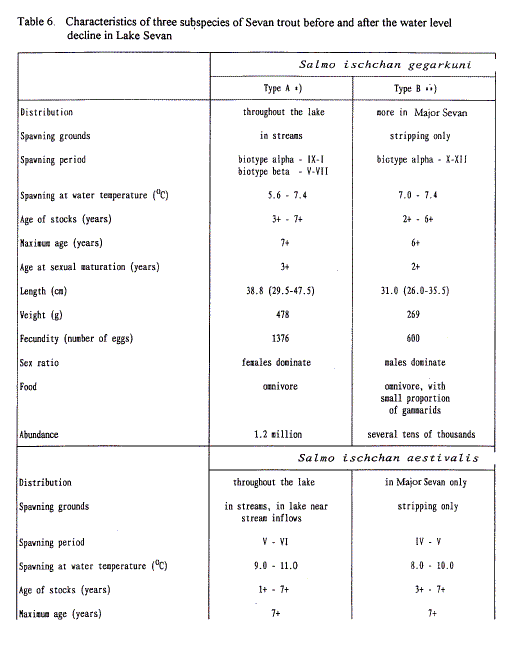
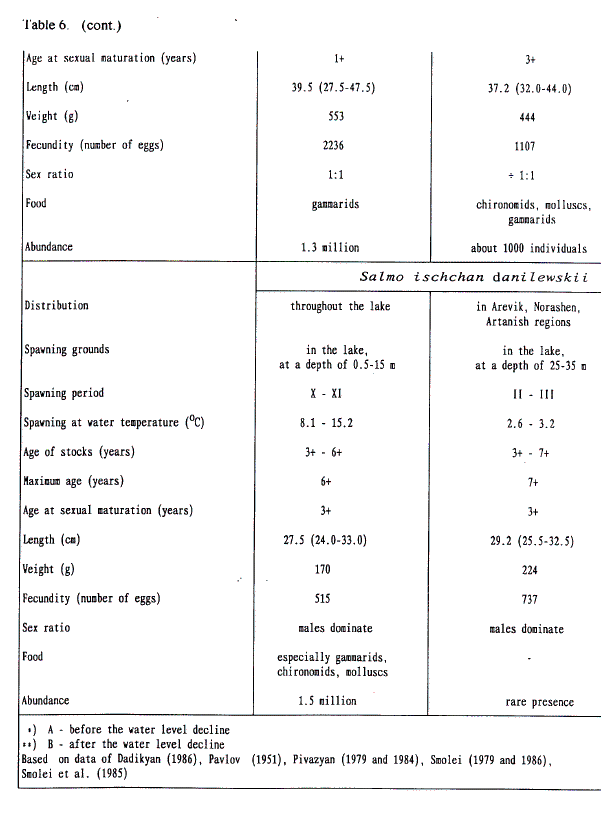
3.1.3 Sevan barbel - Barbus lacerta goktchaicus
Three forms of this fish exist in the Lake Sevan/river system: lake form, transitional lake-river form, and river form. The lake form is strictly limited to the lake where it inhabits travertine and stony bottoms. It grows to a maximum size of 30 cm and weight of 500 g, with some individuals reaching the age of 12+. It is a slow grower. Before the water level started declining, the lake form of Sevan barbel was the most common of the three forms, yielding up to 12 t per year. The decline in water level and the loss of many spawning grounds resulted in a sharp decline in fish stocks of this form. The transitional lake-river form spends most time in the lake but spawns in rivers. About 4 t per year are captured, some of it in rivers. Such fishery may result in a complete removal of all spawners. The river form is the smallest of the three and it is limited to the middle and upper reaches of rivers at an altitude of around 2200 m.
The lake form matures when 4-6 years old; the river form a year earlier. Spawning starts in June at a water temperature of about 14oC and ends in August at a temperature of 18oC. Two batches of eggs are laid, at 12-15 days interval. The fish fry feed on zooplankton; fingerlings feed mainly on gammarids and caddis flies, and on eggs of trout during the trout spawning season. The river form feeds also partly on flying insects (Dadikyan, 1986).
Sevan barbel feeds intensively from May to October. During the cold season the fish feeds little, remaining underneath stones, mostly motionless, until the spring.
Sevan barbel is not a common fish. In the past it represented less than 3% of the total catch. Since then it has become rare.
3.1.4 Sevan whitefish - Coregonus lavaretus sevanicus
Two subspecies of whitefish were introduced into Sevan during 1924-1927: the Ladoga whitefish (C. l. ladoga) and Lake Chud whitefish (C. l. maraenoides). Later on these produced a hybrid. The fish now reproduce in the lake. They spawn in the littoral at 0.5-10 m depth, mainly in the southeastern part of the lake (Dadikyan, 1986; Smolei et al. 1985). After their introduction the fish started to spawn from November to January. The mean body length of the brood stock was between 35 and 50 cm, the fecundity 20,000 to 31,400. The introduced fish grew faster and matured earlier in Sevan than in the original habitat (Yuzhakova, 1985). In the 1940s and 1950s Sevan whitefish spawned at the age of 9-10 years or more (Pavlov, 1947; Mailyan, 1957), but in fish landings the 3-4 year age groups dominated. Gradually, the age structure of whitefish changed and the stocks became much younger (Yuzhakova, 1979): there was a marked increase in the proportion of the fish reaching sexual maturity at an age of 1 to 2 years (body length 28-37 cm). This was seen as a result of the rising lake water temperature as the lake was getting shallower. In the central part of the lake the temperature increased by 4-5oC and in the littoral from 10oC to 16-18oC. It is also believed that the life cycle of this species got shorter as a result of intensive fishing pressure on fish stocks (Yuzhakova, 1985).
While the original purpose of the introduction of whitefish was to provide a better utilisation of zooplankton, in whitefish two years and older gammarids formed the major food item. This led to competition for food with Sevan trout (Fortunatov et al., 1932; Mailyan, 1957). After a number of years the feeding pressure as well as the reduction in submersed macrophytes reduced the biomass of gammarids and the whitefish had to turn back to zooplankton (Pivazyan, 1982).
Whitefish stocks stayed at a low level until 1955. The drop in lake water level by 16 m and eutrophication, especially of shallows, provided better conditions for whitefish and subsequently their stocks increased, increasing fastest at the onset of eutrophication. With more whitefish in the lake commercial fishery for whitefish improved and by the late 1960s whitefish became the major commercial fish. Today they represent about 80% of the total catch of about 1000 t.
4.1 Factors behind the reduction in fish stocks
Until the beginning of the 1960s the lake was oligotrophic. This was followed by gradual eutrophication as a result of man-induced impacts, such as irreversible draining of lake water for hydropower, and increasing inputs of pollutants from the growing number of settlements around the lake. The lake was getting shallower and water temperature range greater with the lake surface now being regularly covered in ice during the winter. There was increased water turbidity, a decrease in dissolved oxygen concentrations and occasional deoxygenation of bottom water layers leading to decline in aquatic macrophytes, while an increase in blue-green algae resulted in "water blooms". The lake bottom also became covered in clay (Table 7). This was accompanied by an increase in the biomass and production of zooplankton and bottom-dwelling chironomids and oligochaetes. Fish yield rose from 10.0 to 20.9 kg ha-1 in the second half of the 1970s (Table 7). There was a dramatic change in fish species dominance. Sevan trout stocks declined sharply, while the introduced whitefish increased from 166.1 t in 1960 to 846.3 t in 1973 (Table 8). Khramulya retained its original density (Yuzhakova and Pivazyan, 1975). Sevan barbel, the annual catch of which was 20 t before the fall in water level, has become rare as a result of poor conditions for its spawning.
With its prevalence of trout (60-65% of the total commercial catch) Lake Sevan used to be a unique water body. The trout population was high because of favourable breeding conditions, supported by stocking, and because of the abundance of gammarids, an abundant food source for trout. Moreover gammarids were not consumed by other fish. The fall in water level affected the spawning grounds of all Sevan trout subspecies and forms except initially S. i. gegarkuni and S. i. aestivalis because hatcheries were able to produced sufficient stocking material. When the lake level started to fall, for a number of years large numbers of eggs (up to 70 million annually) were collected and incubated in hatcheries to produce stocking material for release into the lake. Despite all the effort, Sevan trout stocks began to fall because of new factors which have impacted the trout environment: increased diversion of water for irrigation and increasing discharge of agrochemicals in streams and rivers drained from the irrigated fields, and of industrial and municipal pollutants entering rivers and streams used for the production of stocking material. Furthermore, there was an increase in food competition from the introduced whitefish (Pivazyan, 1972, 1979).
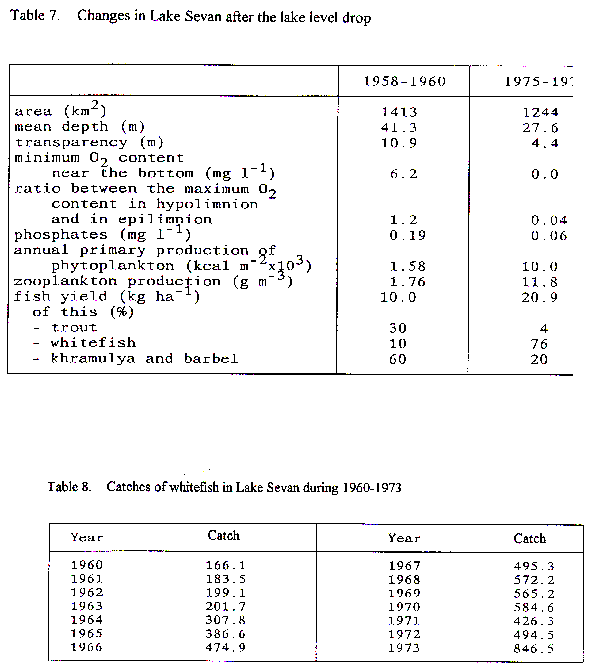
Poaching also takes a substantial blame for the reduction in the stocks of Sevan trout. It has become so serious that it threatens the very existence of the species.
With the fall in water level spawning grounds of Sevan khramulya were disappearing as in the full lake they were situated only 1 m below the water surface. Since the 1960s khramulya stocks have been overfished.
4.2 Changes in fish catches
Before the water level in Lake Sevan started to fall, "winter", "summer" and gegarkuni trouts dominated the catches, while Bodzhak trout was less common. In 1970 gegarkuni trout dominated the catches with 120 t per year, followed by the "summer" trout. In 1975 gegarkuni trout represented 56-70% of the catches, "summer" trout about 20%, while "winter" trout and bodzhak trout accounted for 7-18% (Smolei, 1979, 1979a). This was due to the different impact of the falling water level on spawning grounds of each of the subspecies. The major spawning grounds of "winter" trout dried out in 1963, and aquaculturists failed to find a suitable method for "winter" trout egg incubation. While spawning grounds of the "summer" trout in the lake had dried out much earlier, i.e. in 1948, than those of "winter" trout, the stocks remained stable until the 1960s because the brood stock migrated to spawning grounds in the inflowing rivers. However, with the deterioration of conditions for spawning in the rivers the spawning of "summer" trout became much weaker and setting of fishing nets in the entrances of rivers into the lake has eliminated the chances for natural spawning. Hence rivers are now stocked with young fish produced in hatcheries.
Attempts to arrest the decline in trout stocks in Sevan and rivers included the introduction of large mesh-sized seine nets. In 1971-1973 fishing for trout during the periods of their intensive feeding was prohibited but it was allowed to fish during spawning which captured 50-70 t fish annually. Later on seine nets were banned. In 1976 commercial fishing for trout had to be stopped (Savvaitova et al., 1989).
Khramulya yielded 500-600 t annually until the end of the 1950s, but in the subsequent decade the catches dropped to 260 t per year. In 1961-1970, larger mesh-sized nets were used on a large scale, and khramulya at that time represented 33.5% of the total catch. However, netting was banned in 1971 because they were capturing a disproportionately high percentage of young fish and predominantly males. The ban helped to restore the original structure of the stocks to the level of the 1960s (Smolei et al., 1985).
The proportion of whitefish in catches was steadily increasing from the start of eutrophication of the lake (Table 8) until 1980. By that time the stocks were getting younger, and first spawners dominated in the broodstock. The fish stock changed from that with a long cycle to a short cycle. The pressure of commercial fishing upon whitefish intensified and the proportion of younger fish in catches increased. The prevalence of 2+ and 3+ spawners resulted in a lower fecundity and poor quality of eggs and this lowered the rate of reproduction and reduced the survival rate of juveniles. Only 24% of ripe females spawned in 1980 and there was a high rate of egg resorption (Smolei and Yuzhakova, 1979).
4.3 Hatchery production of stocking material
Stocking of trout produced from hatcheries started in 1923 when 1.4 million trout larvae were released in the lake. The main objective was to increase the abundance of gegarkuni trout and "summer" trout. Two trout hatcheries were producing larvae on a large scale for releases in rivers and streams feeding the lake. Starting in 1926 20 million larvae were stocked annually, of which 80% were gegarkuni trout. During 1949-1956 when most of the trout spawning grounds in the lake dried out (Table 9), the average annual number of released trout fry was 47.3 million, including 37.4 million of gegarkuni. During that time part of the eggs of gegarkuni and "summer" trout collected for incubation were placed in artificial spawning nests in small rivers. During 1956-1970 the Sevan hatcheries produced about 70 million eggs annually. The fry were kept in tanks for 2-3 weeks after hatching and then they were released into rivers. Dadikyan (1975) estimated that 90% of released fry failed to survive the first month after their release. After 1975 the collection of trout eggs sharply decreased: over the period 1975-1987 the number of collected "summer" trout eggs declined from 12 million to 30,000 and those of gegarkuni from 62 million to 6.7 million (Table 10). For the `winter" trout, 0.1 million to 5 million eggs used to be collected, but in 1970, the hatchery production of its seed was stopped. The management strategy dictated by the decreasing number of maturing fish (Table 11) was to collect less eggs and to produce fingerlings of 1-3 g for release. From 1978 on all mature fish migrating to rivers have been used exclusively for stripping. These fish are caught at the mouths of rivers, then stripped of eggs and milt, kept in net cages for 10-14 days to lose their migration instinct, and then released into the lake. The mortality in cages is 2-5%. Poaching pressure has made it impossible to assess whether the released spent females have had a chance to produce another batch of eggs.
Khramulya eggs were incubated in simulated natural conditions already in 1952 (Markosyan et al., 1955). Introduction of Weiss jars much improved the survival of the incubated eggs of which on average 76% hatched, which was 37% more than using the earlier practice (Rubenyan, 1985).
4.4 Lake Sevan as source of stocking material for other water bodies
Regardless of the critical reduction in Sevan trout stocks, the fish management programme still uses the lake as a source of fish for stocking other water bodies. Sevan trout has been introduced in the Ukraine, Kyrgyzstan and Karelia. More than 10 million eggs of whitefish are collected every year from inshore waters to be transferred to lakes of the Urals, Central Asia, Siberia and Georgia. Khramulya is transferred to water bodies in Georgia, and the Moscow and St. Petersburg regions.
Fertilised eggs of gegarkuni trout were brought to Lake Issyk-kul (Kyrgyzstan) in 1930 and 1936. Until the 1960s the stocks of this fish in Lake Issyk-kul remained low because of the lack of suitable spawning grounds. Once hatcheries were established on rivers Ton and Karakol, they provided sufficient numbers of gegarkuni trout for stocking. Commercial fishing for Sevan trout yielded 40-50 t per year during the 1970s and 1980s.

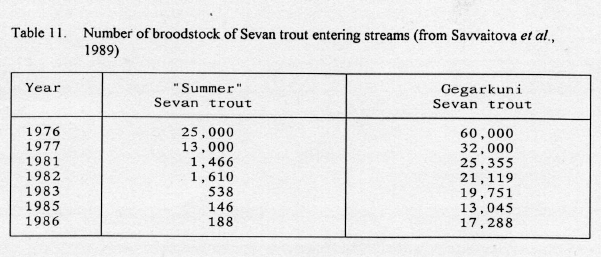
In its new environment gegarkuni acquired several specific characteristics. In Lake Issyk-kul it grows to a larger size than in Lake Sevan, and reaches a length of 89 cm and weight of 17 kg as compared to 60 cm and 4 kg in Sevan. Its growth rate is 4-6 times faster than in Sevan and its fecundity is 5-6 times higher, with the number of eggs ranging from 3300-17,300. In Issyk-kul gegarkuni feed mainly on fish (81.8%) whereas in Sevan only the largest fish were found feeding on khramulya (Dadikyan, 1955). Both the colour and body shape of adults have changed. The migratory form of gegarkuni in Issyk-kul has produced a smaller river form (Luzhin, 1956). Hence, from the time of the first introduction in Lake Issyk-kul the Sevan gegarkuni has undergone considerable changes in its biology. The successful introduction of Sevan trout in Lake Issyk-kul should be considered an important step toward preventing the extinction of this species. In Lake Sevan it is now considered highly endangered as a result of the modified environment which prevents this species from successfully spawning there. Attempts were made to transplant Sevan trout to selected small water bodies in the high mountains of Armenia. In the 1960s gegarkuni was released in lakes Kari (altitude 3185 m, 12.5 ha), Akna (3030 m, 50 ha) and Sev (2666 m, 192 ha). However, these lakes did not provide suitable spawning grounds for gegarkuni, and it was necessary to regularly stock the lakes with fry of 1 g. Artificial spawning grounds were also constructed, but the results are not known.
The introduction of coregonids from Lake Sevan to Issyk-kul began in 1965, with the transfer of eggs to the Ton hatchery. The resulting whitefish fry of 3-4 days were released in the lake. A total of 86.8 million fry were released over the period of 1966-1973, with 2 million fry released initially (1966), peaking in 1969 with 20.5 million, 17.5 million in 1971, 16 million in 1972 and 13.1 million in 1973 (Nikitin, 1976). The first 400 kg of whitefish were captured in the Tyup Bay in 1974.
Sevan whitefish is considered today to be a hybrid of the Ladoga whitefish and Lake Chud whitefish (Shaposhnikova, 1971). Nikitin (1976) described the morphological differences between the original fish and the progenies which evolved from them in Issyk-kul. The Issyk-kul whitefish also have different feeding habits as they feed mainly on benthos (molluscs, mysids) and much less on zooplankton. The growth rate has increased, especially during the first year of life. At the age of 4+ the Issyk-kul whitefish weighs about 1.5 kg as compared with 1 kg for those in Sevan (Nikitin, 1976). Male whitefish in Issyk-kul reach sexual maturity earlier, often already at the age 1+, and females become sexually mature when 2+. Fecundity is high, with 27,500-50,152 eggs (Nikitin, 1976).
In addition to Lake Sevan, a number of other lakes in the Caucasus have fishery potential. Lake Karagel (altitude 3195 m; 16.8 ha), also in Armenia, although considered of no fishery importance, has Sevan trout (Salmo ischchan) which was stocked. Lake Arpagel (2021 m; 2200 ha) has common carp fishery, and its fishery production potential is estimated to be 20-40 t yr-1 (Kasymov, 1972).
In Georgia, Kasymov (1972) and Chkhaidze (1981) mention 10 lakes of 30 ha to 3688 ha surface area with fishery importance. Lake Khanchali (altitude 1930 m, surface area 1375 ha) is so shallow that it freezes almost down to the bottom. This lake, however, has a potential fishery production of 275 t yr-1 if part is converted to ponds or if regularly stocked. Lake Tabiskuri (1990 m; 1440 ha) has trout and two species of coregonids. Its potential fish production is estimated at 100 t yr-1. Lake Sagamo (1994 m; 496 ha) has trout, carp, khramulya (Varicorhinus capoeta), chub (Leuciscus cephalus), coregonids and several other fish species. The lake's fish production potential is estimated to be 40 t yr-1. Khramulya is an indigenous fish in Georgia, it easily adapts to various environments and to different types of food, and it also has a nice tasting flesh. In Georgia it has already been successfully tested in aquaculture conditions (Verulashvili, 1981). Lake Bazaleti (879 m; 124 ha), with no fishery at present, has a fishery production potential of 3.6 t yr-1. Lake Madatapa (2108 m; 885 ha) has been considered for the production of the Paravan race of common carp. Lake Paravan (2060 m; 3680 ha) has common carp, khramulya, chub and coregonids, and its fish production potential is estimated to be 352 t yr-1. Lake Bareti (1587 m; 155 ha) has not been considered yet for fishery production.
For efficient management of lakes and reservoirs in Georgia Chkhaidze (1981) estimated that 38 million fry/fingerlings are needed, including 4 million of common carp, 10 million of fish feeding on phytoplankton or aquatic macrophytes (including 9 million of silver carp), 2 million trout, and 15 million khramulya. At the beginning of the 1980s, Georgian hatcheries were producing only 3.5 million common carp, 2 million khramulya, 4-5 million coregonids, and no silver carp.
In Abkhazia Lake Bebesini (159 ha) fish production potential is estimated to be 4.7 t yr-1 (Kasymov, 1972). Rudd (Scardinius erythrophthalmus), perch, tench, bream, pike, wels, Alburnus charusini and several other fish species are present in the lake. Lake Ritsa (altitude 925 m) harbours trout stocks.
For Azerbaijan Kasymov (1972) mentioned 10 lakes of fishery importance. Among them, Lake Geigel (1571 m; 79 ha) has trout which supports recreational fishery.
To summarise: in the countries of the Caucasus a number of coldwater lakes, all considerably smaller than Lake Sevan, appear to be suitable for fish production. The prime candidates are the following fish species: the indigenous khramulya, which in most such lakes should find sufficient supply of its favourite food, i.e. periphyton, detritus and algae. Coregonids and silver carp would complement the fish community as plankton feeders. The indigenous race of common carp from the high altitude Lake Paravan appears a suitable addition to the above species.
Lake Sevan is one of the increasing number of lakes in Asia which have been under major stress from human activities. Lake Sevan, with its 1244 km2 in surface area is a major source of hydroelectric power. Between 1940 and 1978 its water level was wildly fluctuating as a result of hydropower production and withdrawals for irrigation. The danger of continuing to drain water was recognised in 1979 and further draining was stopped. However, with the war between Armenia and Azerbaijan in the early 1990s, which resulted in an oil blockade, the draining of Lake Sevan for hydropower was restarted. The unsettled hydrological conditions, combined with a process of eutrophication as a result of the combined effects of shallower lake and increased inputs of nutrients from human settlements around the lake and industries, greatly impacted on the original fish stocks. Sevan trout, the most valuable species in Sevan, became highly endangered and its proportion in fish landings dropped to 1% today as compared to 60-65% before the lake water became manipulated.
A number of measures were undertaken to arrest further deterioration of the lake. More water was brought to the lake from other catchments through several tunnels, which resulted in an increase of 1.5 m in lake water level. A ban on fishing for Sevan trout was imposed in 1976, and the Lake Sevan National Park created in 1978. Still, the damage continued, also because of the continuing eutrophication of the lake. After the detection in 1970-1973 of near-bottom anoxia, with the presence of hydrogen sulfide and methane, the lake experienced massive fish kills in 1983. In 1976 the fishing for trout was prohibited to protect the remaining stocks, but poaching continued as the prohibition was poorly enforced in a period of severe economic restriction (Meybeck et al., 1997). Introduction of coregonids provided new fishery, which started in the 1970s and culminated in 1982 with 16,000 t per year. Afterwards there was a sharp decline.
The lake level drop reduced the macrophyte belt by 30 fold, with drastic changes in littoral, where Gammarus, an important food source for the Sevan trout, virtually disappeared. The eutrophicated lake is now rich in green and blue-green algae culminating in occasional blooms. Water transparency has declined from 12.5 m to 4.5 m (Meybeck et al., 1997). While the hydroelectric plant is now switched on only in emergency situations, such as that caused by the oil embargo imposed on Armenia by neighbouring Azerbaijan in 1993, this causes further drop in Lake Sevan water level. An alternative was restarting an obsolete nuclear power station to alleviate the shortage of electric power in the country (Herald Tribune, August 13, 1993) which would prevent further deterioration of the lake and its fish stocks.
Meybeck et al. (1997) summarized the causes of the near extinction of the Sevan trout:
Restoration of Lake Sevan anticipates an increase in the lake level by 6 to 8 m and decreased inputs of nutrients, which combined should reduce the current level of eutrophication and improve dissolved oxygen conditions (Hovhanissian, 1994). A higher water level would restore some of the lost spawning grounds of Sevan trout, khramulya and barbel. Further spawning grounds should be created from gravel, both in the lake and in the inflowing rivers. Sevan trout transferred in the past into Lake Issyk-kul should be reintroduced to enrich the gene pool of the stocks remaining in Lake Sevan. However, it is believed that the lake will probably never recover its pristine state.
The current difficult economic situation in Armenia has led to a decline in research and monitoring. Meybeck et al. (1997) conclude that reactivating regular scientific work and monitoring will depend on the economic recovery of the country and international assistance.
Arnoldi, L.V. 1929. Bottom productivity in Lake Sevan. Trudy Sevanskoi Gidrobiol. Stantsii 1(1): 1-96). (In Russian).
Bagramyan, G.A. 1984. Hydrobiological regime and technical measures for solving the problems of Lake Sevan. In: Limnologia Gornykh Vodoemov: 17-18. AN Arm. SSR, Erevan. (In Russian).
Chkhaidze, R.I. 1981. Phytoplankton in Lake Sagamo. In: Fishery investigations of inland water bodies in Georgia: 7-13. Collected Papers. VNIRO, Moscow. (In Russian).
Dadikyan, M.G. 1955. Nutrition of Sevan trouts. Trudy Sevanskoi Gidrobiol. Stantsii 14: 5-76. (In Russian).
Dadikyan, M.G. 1975. Biology of the young Sevan trout. Biol. Zh. Armenii 28(12): 12-20. (In Russian).
Dadikyan, M.G. 1986. Fishes of Armenia. AN Arm. SSR, Erevan. 245pp. (In Russian).
Fortunatov, M.A. 1927. Lake Sevan trout co-species Salmo ischchan Kessler. Trudy Sevanskoi Gidrobiol. Stantsii 1: 1-131. (In Russian).
Fortunatov, M.A., K.R. Fortunatova and E.V. Kulikova. 1932. Evaluation of natural resources in Lake Sevan. Trudy Sevanskoi Gidrobiol. Stantsii 3: 1-182. (In Russian).
Fridman, G.M. 1950. Bottom fauna of Lake Sevan. Trudy Sevanskoi Gidrobiol. Stantsii 10: 7-92. (In Russian).
Gabrielyan, B.K. and M.I. Shatunovsky. 1984. Long-term changes in fecundity of Sevan khramulya and factors determining it. In: Limnologia Gornykh Vodoemov: 50-52. AN Arm. SSR, Erevan. (In Russian).
Gabrielyan, B.K. and L.N. Tryapitsyna. 1984. Long-term changes in fecundity in the Sevan khramulya and the factors behind it. In: Limnologia Gornykh Vodoemov: 48-50. AN Arm. SSR, Erevan. (In Russian).
Gabrielyan, B.K. et al. 1990. Abundance and biomass of Sevan khramulya (Varicorhinus capoeta sevangi Fill.) in a changing water body. Ekologia 2: 46-53. (In Russian).
Gambaryan, M.G. 1979. Temperature regime of Lake Sevan. Trudy Sevanskoi Gidrobiol. Stantsii 17: 123-129. (In Russian).
Gezalyan, M.G. 1979. Temperature regime of Lake Sevan. Trudy Sevanskoi Gidrobiol. Stantsii 17: 5-23. (In Russian).
Gezalyan, M.G. and L.I. Khorlashko. 1979. Oxygen regime of Lake Sevan. Trudy Sevanskoi Gidrobiol. Stantsii 17: 24-37. (In Russian).
Hovhanissian, R.H. (Oganessian, R.O.). 1994. Lake Sevan yesterday, today. Armenia Nat. Acad. Sci., Erevan. 478pp. (In Russian).
Kasymov, A.G. 1972. Freshwater fauna of Caucasus. Elm, Baku. 285pp. (In Russian).
Kazaryan, A.G. 1979. Phytoplankton of Lake Sevan. Trudy Sevanskoi Gidrobiol. Stantsii 17: 75-87. (In Russian).
Legovich, N.A. 1979. "Water bloom" in Lake Sevan during 1964-1972. Trudy Sevanskoi Gidrobiol. Stantsii 17: 51-74. (In Russian).
Leshchinskaya, A.S. 1950. Reproductive biology of trout in Lake Sevan. Trudy Sevanskoi Gidrobiol. Stantsii 10: 93-175. (In Russian).
Luzhin, B.P. 1956. Issyk-kul trout gegarkuni. AN Kirgiz. SSR, Frunze. 133pp. (In Russian).
Lyatti, C.Ya. 1932. Hydrochemical features of Lake Sevan. In: Materialy po Issledovaniyu Ozera Sevan i ego Basseina. Erevan. 101pp. (In Russian).
Mailyan, R.A.1957. Whitefish of Lake Sevan. Trudy Sevanskoi Gidrobiol. Stantsii 15: 136-196. (In Russian).
Markosyan, A.G. 1959. Benthos production in Lake Sevan. In: Trudy VI Soveshchaniya po Problemam Biologii Vnutrennikh Vod: 139-145. Moscow, Leningrad. (In Russian).
Markosyan, A.G. et al. 1955. Stripping and rearing of Sevan khramulya. Izv. AN Arm. SSR 8(7): 15-28. (In Russian).
Meshkova, T.M. 1976. Eutrophication of Lake Sevan. Biol. Zhurnal Armenii 29(7): 14-22. (In Russian).
Mina, M.V. 1986. Microevolution in fishes. Nauka, Moscow. 207pp. (In Russian).
Meybeck, M., M. Akopian and V. Andreassian. 1997. What happened to Lake Sevan? SIL News 23: 30 June 1997: 7-10.
Nikitin, A.A. 1976. Introduction and artificial production of whitefish in water bodies of Kirgizia. Ilim, Frunze. 121pp. (In Russian).
Nikogosyan, A.A. et al. 1979. Zooplankton distribution in Lake Sevan. Trudy Sevanskoi Gidrobiol. Stantsii 17: 118-122. (In Russian).
Oganesyan R.O. and A.S. Parparov. 1983. Ecological aspects of Lake Sevan problems. Trudy Sevanskoi Gidrobiol. Stantsii 18: 5-13. (In Russian).
Oganesyan, R.O., A.S. Parparov and A.A. Simonyan. 1977. Biological principles of Lake Sevan problems. Biol. Zh. Armenii 30(10): 101-106. (In Russian).
Ostrovsky, I.S. 1983. Productivity of the common zoobenthos species and their role in Lake Sevan ecosystem. Moscow (thesis). 24pp. (In Russian).
Parparov, A.S. 1990. Some characteristics of the community of autotrophs of Lake Sevan in connection with its eutrophication. Hydrobiologia 191: 15-21.
Parparova, R.M. 1979. Hydrochemical conditions in Lake Sevan in 1976. Trudy Sevanskoi Gidrobiol. Stantsii 17: 38-50. (In Russian).
Pavlov, D.S., K.S. Savvaitova and V.G. Markaryan. 1989. Ecological monitoring and the potential for saving trout Salmo ischchan (Kessler, 1877) in Lake Sevan. Vestnik Moskovskogo Universiteta, Ser. Biol. 1: 73-78. (In Russian).
Pavlov, P.I. 1947. Spawning grounds and the impact of the fall in water level on trout population in Lake Sevan. Trudy Sevanskoi Gidrobiol. Stantsii 12: 93-140. (In Russian).
Pavlov, P.I. 1951. Contribution to the Sevan trout biology. Trudy Sevanskoi Gidrobiol. Stantsii 12: 93-140. (In Russian).
Pivazyan, S.A. 1972. Nutrition and feeding relationship between the trout Salmo ischchan Kessler and whitefish Coregonus lavaretus ladoga Polakov in Lake Sevan. Voprosy Ikhtiol. 12(6): 1086-1093. (In Russian).
Pivazyan, S.A. 1979. Nutrition of salmonids in Lake Sevan. Trudy Sevanskoi Gidrobiol. Stantsii 17: 153-161. (In Russian).
Pivazyan, S.A. 1984. Nutrition and feeding relationship between trout and whitefish in Lake Sevan. Trudy Sevanskoi Gidrobiol. Stantsii 19: 151-253. (In Russian).
Red Book of the USSR. 1984. Vol. 1. Lesnaya Promyshlennost, Moscow. 390pp. (In Russian).
Rubenyan, A.R. 1985. Method of artificial rearing of Sevan khramulya. Trudy Sevanskoi Gidrobiol. Stantsii 20: 245-253. (In Russian).
Savvaitova, K.A., E.A. Dorofeeva, V.G. Markaryan and A.I. Smolei. 1989. Trouts of Lake Sevan. Trudy Zool. Inst. AN SSSR (Leningrad). Vol. 204. 180pp. (In Russian).
Shaposhnikova, G.Kh. 1971. Comparative morphology of the genus Coregonus from Lake Sevan. Voprosy Ikhtiol. 11(4): 575-586. (In Russian).
Simonyan, A.A. 1988. Zooplankton in changing conditions of a water body (case study: Lake Sevan). Leningrad (thesis). 43pp. (In Russian).
Smolei, A.I. 1979. Biology and abundance of Sevan trout in changing lake conditions. Trudy Sevanskoi Gidrobiol. Stantsii 17: 181-211. (In Russian).
Smolei, A.I. 1979a. Dynamics of abundance of salmonids in Lake Sevan in a changing environment. Trudy Sevanskoi Gidrobiol. Stantsii 17: 221-227. (In Russian).
Smolei, A.I. 1986. Biological aspects of increasing the abundance of Sevan trout. In: Dinamika Chislennosti Promyslovykh. Ryb: 160-166. Nauka, Moscow. (In Russian).
Smolei, A.I., S.A. Pivazyan and G.G. Yuzhakova. 1985. Fish resources in Lake Sevan during the falling water level and potential for their exploitation. Trudy Sevanskoi Gidrobiol. Stantsii 20: 199-244. (In Russian).
Smolei, A.I. and G.G. Yuzhakova. 1979. Abundance of salmonids in Lake Sevan in 1971-1975. Trudy Sevanskoi Gidrobiol. Stantsii 17: 212-220. (In Russian).
Yuzhakova, G.G. 1979. Abundance of Sevan whitefish in 1961-1970. Trudy Sevanskoi Gidrobiol. Stantsii 17: 172-181. (In Russian).
Yuzhakova, G.G. 1985. Growth and sexual maturation of Sevan whitefish. Trudy Sevanskoi Gidrobiol. Stantsii 20: 188-198. (In Russian).
Yuzhakova, G.G. and S.A. Pivazyan. 1975. Abundance of introduced whitefish in Lake Sevan. Izv. Gosudar. Nauch.-issled. Inst. Ozer. Rech. Ryb. Khoz. (GOSNIORKh), Leningrad, 103: 202-206. (In Russian).
Verulashvili, G.G. 1981. Khramulya (Varicorhinus capoeta), a useful fish for fishery. In: Fishery investigations of inland water bodies in Georgia: 65-69. VNIRO, Moscow. (In Russian).